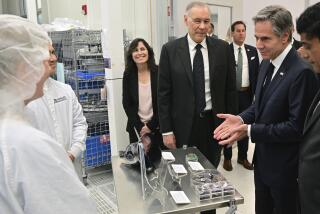Lockheed 10-Year Plan: $10 Billion for Projects, Primarily in California
- Share via
Lockheed Corp. has disclosed a strategic plan to spend $10 billion over the next decade on research and facilities construction, concentrated on its Southern California and Silicon Valley aerospace facilities.
The plan, described by Ben Rich, president of Lockheed Advanced Aeronautics Corp., in a recent interview and confirmed by other Lockheed officials, includes a significant expansion of the firm’s Kelly Johnson Research Center, located about 45 miles northeast of Los Angeles.
Lockheed will build as many as five technical facilities there and increase employment from 400 to as many as 3,000 scientists, engineers and technicians, Rich said.
The expansion will make the center what is believed to be the largest private aerospace research center in the world, complete with supersonic wind tunnels, a computerized weapons simulator, radar ranges, material laboratories and acoustics chambers, he said.
At the same time, Lockheed will continue to reduce its operations at Burbank, transferring increasing amounts of engineering work to the new center and production to its assembly facilities in Palmdale, Rich said.
Earned Record $344 Million
Lockheed had previously announced plans to move its corporate headquarters from Burbank to Calabasas next year.
The ambitious expansion plan reflects Lockheed’s surging profits, which have set records in each of the last three years. The company earned a record $344 million in 1984, up 31% from 1983, and posted a $22.8-billion order backlog, equal to three years of work.
Lockheed’s massive commitment in research and capital spending also substantially ups the ante among aerospace firms seeking the next generation of military programs, which will be fewer in number and more hotly contested. Air Force and Navy orders during the rest of this century are not expected to be enough to support the U.S. aircraft industry at its current size, even though the space and defense electronics businesses will continue to grow, experts agree.
“If you look at Lockheed aircraft sales, they go up in a bubble until 1989 and then they collapse unless we get a new program,” Rich said. “We have to structure the company so that, if we have to contract or expand, we will be in a position to do it.”
Rich was referring primarily to the C-5B program, a $7.8-billion program to build 50 of the large Air Force cargo transports. Financial analysts also say Lockheed has a multibillion contract to produce classified “stealth” fighters, planes that are invisible to radar.
$6 Billion on Missiles, Space
Lockheed is aiming much of its research efforts at winning the advanced tactical fighter, the Air Force’s next generation of jet fighter and one of the few major programs looming before aircraft producers.
“In 1988, I will have a whole cadre of engineers ready to go,” Rich said. “I am saying, ‘Mr. Air Force, if you want a new fighter, I am ready.’ ”
The Lockheed plan is to spend about $6 billion of the $10-billion investment on its missiles and space business, headquartered in Sunnyvale, and $4 billion on its aeronautics business, which will be headquartered at a new office at the Kelly Johnson center, Rich said.
The scientific center is located at a sprawling 600-acre site nestled between the San Gabriel and Santa Susanna mountains. It is named after Lockheed aircraft designer Kelly Johnson, who is credited with designing 40 aircraft, including the SR-71, the 1960s spy plane that is still the fastest and highest-flying aircraft in the world.
About half of the $10 billion would be spent on construction of new facilities and half on research and preparations to make contract bids.
The construction will be primarily at Kelly Johnson, Lockheed’s missile and electronics operation at Sunnyvale and possibly Palmdale. Other investments will go to Lockheed’s Georgia facility and the firm’s aircraft service operation in Ontario.
Lockheed will spend $55 million this year on construction of a weapons simulator at the Kelly Johnson center, a large computer-operated facility to be used in the design and development of all types of weapons, Rich said. Another $70 million will be spent on the facility to bring it to full-scale operation by 1987.
The buildup of employment at the center will be partly from new hiring but also from the transfer of employees from Burbank and Georgia, he said.
The reduction of Burbank operations has long been expected. Lockheed already has discontinued assembling aircraft in Burbank and has shifted increasing amounts of production work to its facilities in Palmdale.
The firm is also planning to move to the Kelly Johnson center the so-called Skunk Works, the unit that builds highly classified aircraft and missiles. The unit is now part of Lockheed California Co., a manufacturing and development organization in Burbank.
Rich also said Lockheed could potentially expand manufacturing operations at its Palmdale site, where it now uses only about one-third of the 680 acres it owns. The expansions will occur if the firm wins the advanced tactical fighter, he said.
Lockheed plans to explore unique ideas for the new jet, Rich said, such as building aircraft that would be much less expensive but whose airframes would also wear out more quickly.
“I want to design aircraft for wars, not peace,” Rich said. “What do I mean by that? In peacetime, maybe I should design things that you can throw away and keep only a few good ones for war.
“Airplanes have become too expensive. In wartime, we might need an aircraft only six months or a year. I can make paper cups that I throw out. Diapers. I want to find a new way of building airplanes,” he said.
More to Read
Inside the business of entertainment
The Wide Shot brings you news, analysis and insights on everything from streaming wars to production — and what it all means for the future.
You may occasionally receive promotional content from the Los Angeles Times.











